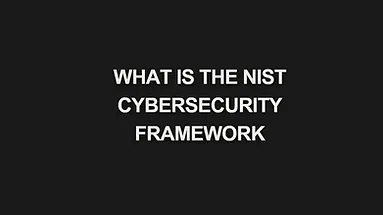The NIST Cybersecurity Framework is a set of guidelines developed by the National Institute of Standards and Technology (NIST) to help organizations manage and reduce cybersecurity risks. Established in response to Executive Order 13636, which aimed to improve critical infrastructure cybersecurity, the framework was first released in 2014 and has since become a widely adopted tool for enhancing cybersecurity practices across various industries. The NIST Cybersecurity Framework (often referred to simply as the “Framework”) provides a comprehensive approach to managing cybersecurity risks through a combination of best practices, standards, and guidelines.
Purpose and Importance of the NIST Cybersecurity Framework
The primary goal of the NIST Cybersecurity Framework is to provide a common language and a systematic approach for organizations to understand, manage, and reduce their cybersecurity risks. It is designed to be flexible, scalable, and adaptable, making it suitable for businesses of all sizes, from small enterprises to large multinational corporations. By following the framework, organizations can enhance their cybersecurity posture, protect sensitive information, and respond effectively to cyber threats.
One of the key benefits of the NIST Framework is its emphasis on risk-based decision-making. Rather than offering a one-size-fits-all solution, it encourages organizations to tailor their cybersecurity strategies based on their unique risk profiles, business requirements, and threat environments. This flexibility allows organizations to prioritize their resources and focus on the most critical aspects of their cybersecurity defenses.
Structure of the NIST Cybersecurity Framework
The NIST Cybersecurity Framework is built around three main components:
- The Core
- Implementation Tiers
- Profiles
1. The Core
The Core of the Framework is its heart and defines a set of cybersecurity activities, outcomes, and references that are common across industries. It is divided into five high-level functions that represent the key areas of cybersecurity risk management. These five functions are:
- Identify: This function focuses on developing an understanding of the organization’s risk environment and identifying critical assets, systems, data, and capabilities. It involves assessing the risks to those assets and understanding how they could be affected by a cyberattack. Key activities include asset management, risk assessment, and governance.
- Protect: This function involves implementing safeguards to limit or contain the impact of a potential cybersecurity event. Protection strategies may include access control, data security measures, training programs, and the development of secure systems and networks.
- Detect: The Detect function focuses on identifying cybersecurity incidents in a timely manner. It involves continuous monitoring, anomaly detection, and maintaining situational awareness to ensure that any deviations from normal operations are promptly noticed and investigated.
- Respond: The Respond function outlines the steps to take when a cybersecurity incident occurs. This includes developing and implementing appropriate actions to contain the impact of the incident, communicating with stakeholders, and learning from the event to improve future responses.
- Recover: The Recover function emphasizes resilience and recovery from cybersecurity incidents. It involves restoring systems and services to normal operations, minimizing the impact on business operations, and applying lessons learned to enhance future protection and detection strategies.
These five functions are further broken down into categories and subcategories that provide more specific guidance on achieving the objectives outlined in each function.
2. Implementation Tiers
Implementation Tiers describe the degree to which an organization’s cybersecurity risk management practices align with the NIST Framework’s goals. The tiers range from Partial (Tier 1) to Adaptive (Tier 4), indicating the level of sophistication and maturity of the organization’s risk management practices. These tiers help organizations assess their current cybersecurity posture and determine the level of risk management they aim to achieve. The four tiers are:
- Tier 1: Partial – Risk management is not formalized, and cybersecurity activities are reactive and inconsistent.
- Tier 2: Risk Informed – Some risk management practices are in place, but they are not fully integrated into organizational processes.
- Tier 3: Repeatable – Risk management is consistent, and there are formal policies in place that guide cybersecurity activities.
- Tier 4: Adaptive – The organization proactively adapts its cybersecurity strategies based on changing threats and continuous learning from incidents.
3. Profiles
Profiles represent the alignment of an organization’s cybersecurity activities with its business requirements, risk tolerances, and resources. They provide a way for organizations to map out their current state (“Current Profile”) and their desired state of cybersecurity (“Target Profile”). By comparing these profiles, organizations can identify gaps in their cybersecurity practices and develop a plan to reach their desired security posture.
Benefits of the NIST Cybersecurity Framework
The NIST Cybersecurity Framework offers numerous benefits to organizations looking to strengthen their cybersecurity efforts:
- Common Language: It provides a standardized approach and common language that helps bridge the gap between technical and non-technical stakeholders, making it easier to communicate about cybersecurity risks.
- Flexibility and Adaptability: The framework’s flexible nature allows it to be adapted to different industries, organizational sizes, and levels of cybersecurity maturity. It does not prescribe specific technologies or solutions, allowing organizations to choose what best fits their needs.
- Risk-Based Approach: It focuses on managing cybersecurity risks based on an organization’s specific environment and risk profile. This helps prioritize efforts on the most critical vulnerabilities and allocate resources more efficiently.
- Continuous Improvement: The framework encourages continuous improvement by promoting regular reviews and updates to an organization’s cybersecurity practices. This dynamic approach ensures that organizations can stay ahead of emerging threats.
Conclusion
The NIST Cybersecurity Framework is a vital tool for organizations striving to enhance their cybersecurity measures in a structured, scalable, and effective manner. By focusing on the core functions of Identify, Protect, Detect, Respond, and Recover, the framework provides a comprehensive approach to managing cybersecurity risks. Its adaptability and emphasis on continuous improvement make it an essential guide for businesses seeking to safeguard their digital assets and protect against the ever-evolving landscape of cyber threats. Whether an organization is just beginning to build its cybersecurity program or looking to mature its existing practices, the NIST Cybersecurity Framework offers valuable insights and practical guidance for achieving robust cyber resilience.





Your article helped me a lot, is there any more related content? Thanks!